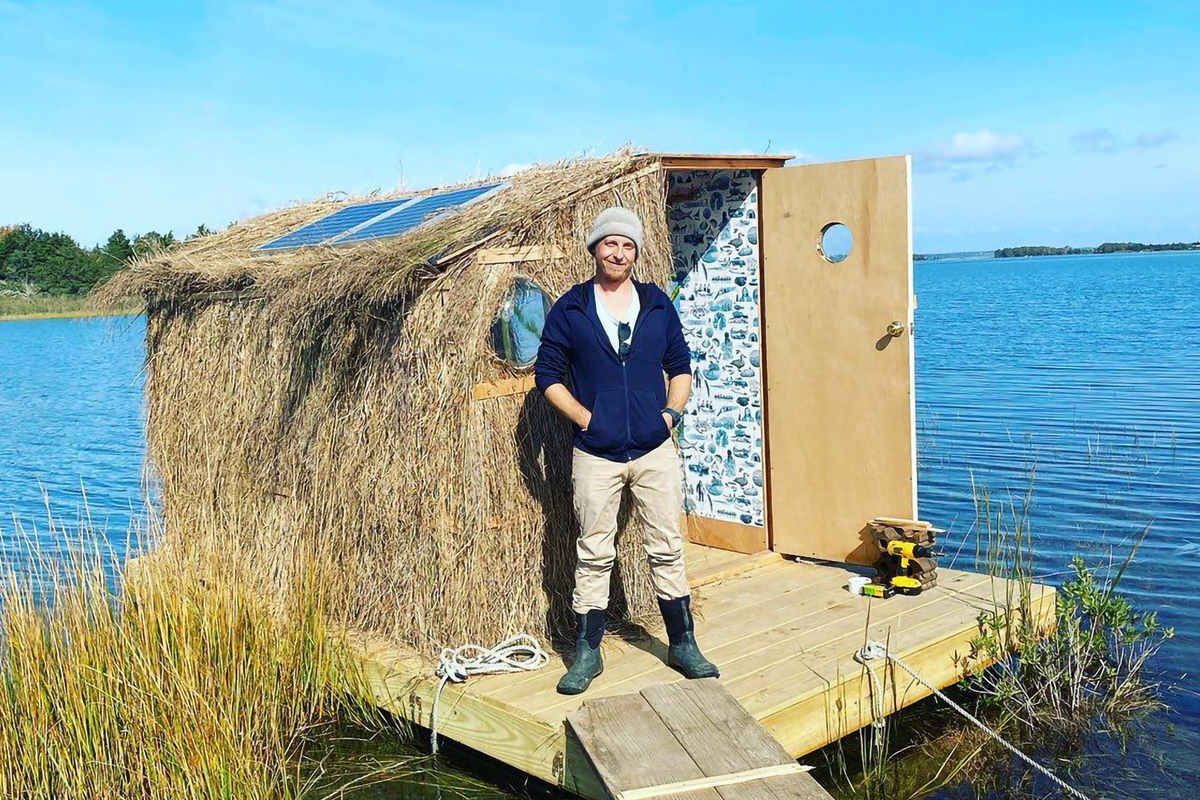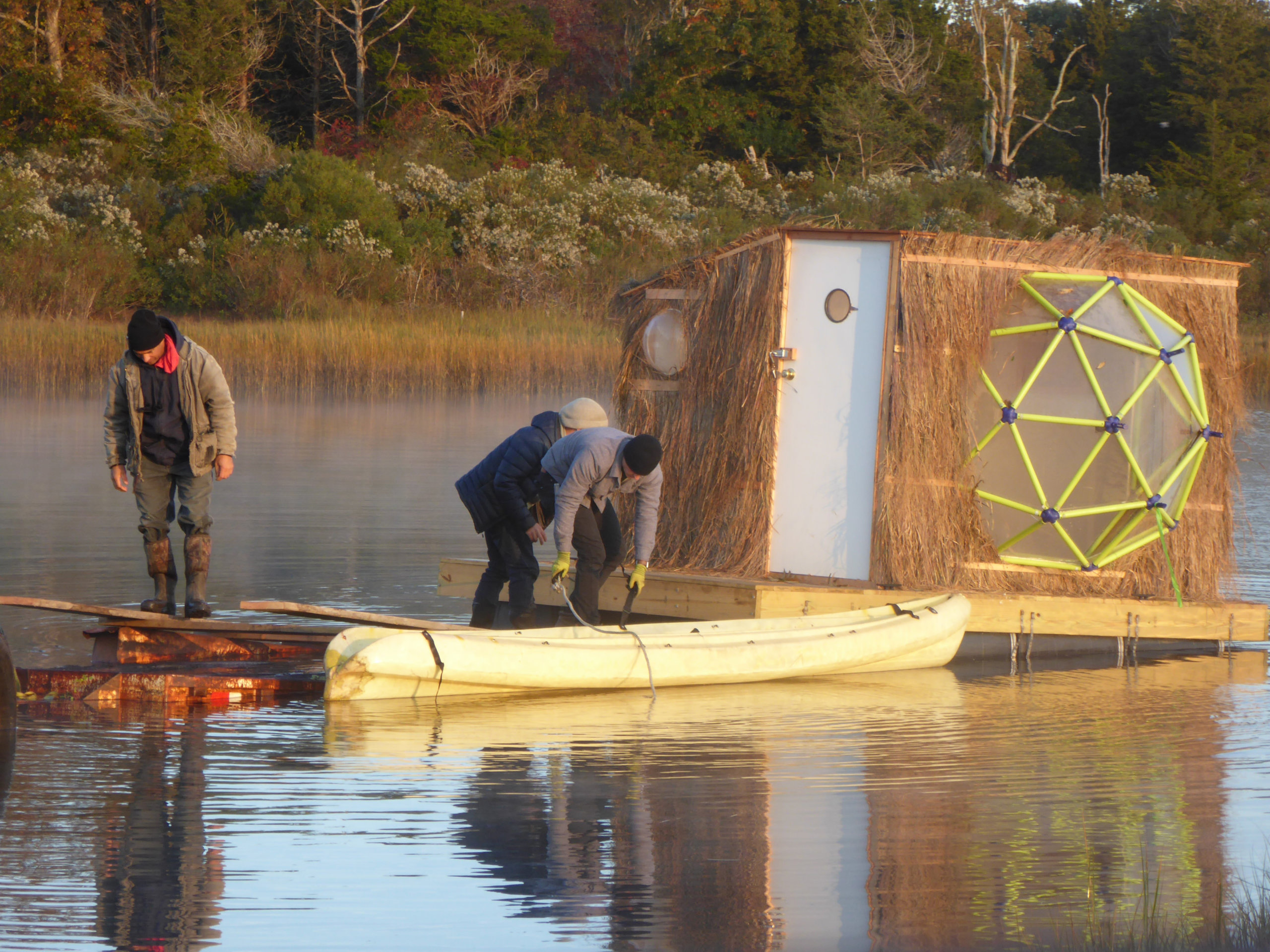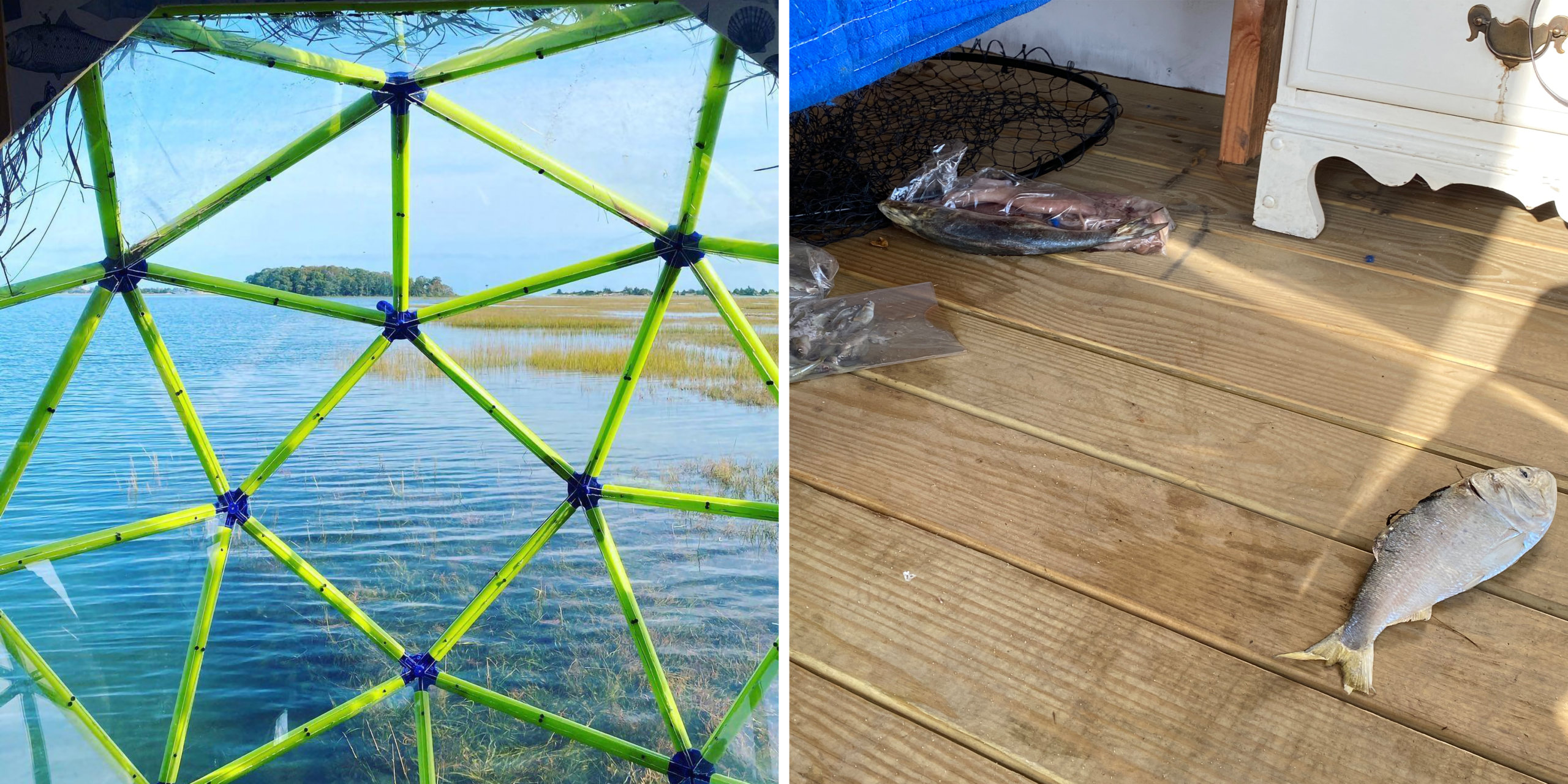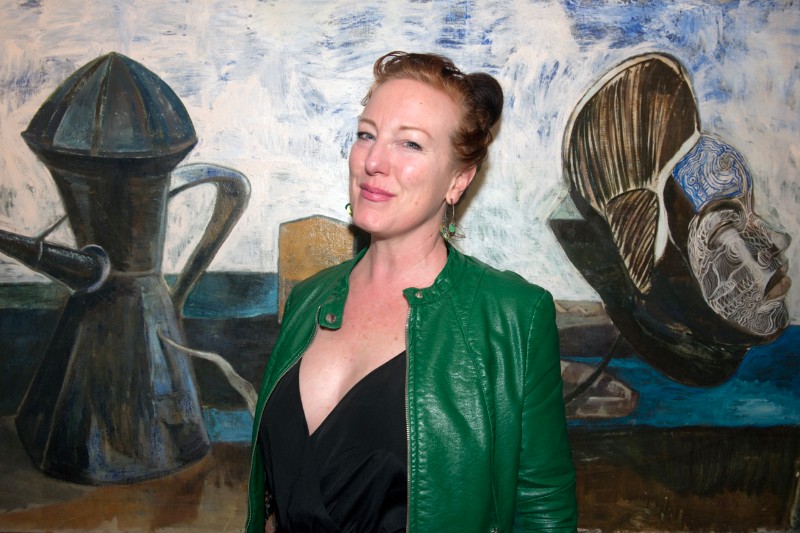All Eyes on Bonac Blind: Art Sparks Vandalism & Conversation

The comingling of cultures in the Hamptons, the adjacency of farms and mansions, of billionaires and Bonackers, has long been woven into the fabric of its appeal. It is also part of an undercurrent of clashes that often go unseen by many. That is, until something brings things back into focus.
Such a moment arrived in October, albeit unintended, when East Hampton artist Scott Bluedorn debuted a unique art installation on Accabonac Harbor as part of the Parrish Art Museum’s Parrish Road Show—the “Bonac Blind,” a floating duck blind and livable mini-home with multilayered meaning behind it.
The message “honors the older traditions of the area, fishing, farming, hunting, being close to the land and the environment—those are things that are built into the local counter culture of Springs,” Bluedorn explains. “One could also say that a lot of families have been displaced because of affordability, the housing crisis and the gentrification of that area, and the whole area in general. You can hear it in the name itself, ‘Bonac Blind,’ as well. It’s a double entendre, meaning the current culture is blind to the fact that people of this culture exist, and it’s eroding.”

The culture Bluedorn is spotlighting is that of the Bonackers, the founding settler families of Springs who have attempted to remain in the Accabonac Harbor area and throughout East Hampton for generations despite the rising cost of living pushing them and other multi-generational families out.
“It wakes people up to the fact of this older culture that is closer to the natural world than we are now—in touch with the rhythm of tides, bird migrations and fish migrations, and that’s really important, because as the makeup of the town changes, I think a lot of that is lost,” Bluedorn says, clarifying that he isn’t a Bonacker himself. “I just want to make sure that people know what the founding principles are, and that goes back to the Montaukett tribes that lived in that area and were, in turn, displaced by the settler families. So it also speaks to the fact that people are constantly being displaced, either forcefully or by their own will. I just want people to look at that history and know that it’s there and that we’re not just ‘The Hamptons’ as its portrayed in media—giant mansions, everyone’s rich and it’s like a resort—it is that, unfortunately, but it’s not all that.”
Shortly after unveiling “Bonac Blind,” Bluedorn was surprised to find that the town trustee’s permit posted at the installation site, acknowledging his permission to dock his art piece on Accabonac Harbor, had gone missing. Next, he noticed that it looked like someone had kicked in a few of the structure’s plexiglass windowpanes. The next day, before he had a chance to replace the windowpanes, he discovered that someone had thrown dead fish, squid and bait through the opening. In addition to the minor damage to the duck blind, a homemade metal caltrop (a tire-flattening device) was found in the parking lot leading to the installation.
While Bluedorn doesn’t have concrete evidence to an organized attack on “Bonac Blind” and is not looking to point fingers or find the people responsible, he does have a suspicion that he offended the very group he was trying to honor. “I thought there was a possibility that some of the same people who I’m trying to honor wouldn’t want that attention or would take it the wrong way,” Bluedorn says. “There has been an anti-art, anti-city-person vibe among these people, and for them to take it the wrong way, like I’m invading their space or bringing them unwanted attention, I thought could be possible.” He adds, “Fish being thrown in there may have been a calling card, but there was no message or reason given.”

Bluedorn later replaced the plexiglass windowpanes and trustee’s permit, adding a second sign explaining his respectful intentions for “Bonac Blind” in case there was a misunderstanding, but that sign and the second permit also disappeared shortly after. When he disclosed the events that befell “Bonac Blind” on social media, the East End arts community responded with notes of support but made it clear that the unfortunate nature of this news was far from surprising.
“I still see the ‘Bonac Blind’ as a sign of hope, because it generated a tremendous amount of positive responses from dozens of visitors,” says Corinne Erni, Parrish Road Show organizer and Senior Curator of ArtsReach and Special Projects. “It saddens me that there were people who felt offended and saw it as an easy target to anonymously express their anger rather than engage in an open conversation. Scott’s work is a labor of love that addresses issues that he, as a local artist, is concerned about—the disappearance of traditions, the environment, and affordable housing. He created an enjoyable experience while asking questions. That’s what good art does.”
“I have had some remote works that were site specific vandalized and recently one stolen,” visual artist and master builder Randy Polumbo shares. “In a grotesque way, they are at least reacting to the work. Perhaps this makes the project more powerful and fills it with energy.”
Although there has been nobody yet deemed responsible for this action, that is almost beside the point. “There are people who feel that art is not for them—that its sheer existence in their world is unwelcoming, meant only for those with means,” Southampton Arts Center Artistic Director Amy Kirwin explains. “But the beauty of Scott’s work and so many others, especially on the East End, is the inspiration taken from the cherished history of the region. It’s important to present projects like this that move outside the walls of museums, galleries and art centers in order to show people that art is a part of life, that it comes in many forms, and it truly is for everyone.”
“It’s disheartening, but keep the faith. There is a deep seam of anger running through our community and country,” photographer and Canio’s Books co-owner Kathryn Szoka comments. “I hope the vandalism was documented, because it is part of the public art installation and may ultimately prove fruitful in some unknown way. Who knows, it could lead to some kind of bridge building.”

Founder of dance theater company The Neo-Political Cowgirls Kate Mueth reveals that she has “had retaliatory actions taken against me at my home due to public art supported by East Hampton Town,” shedding light on the fact that anti-art sentiments have reared their heads in the Hamptons before “Bonac Blind.”
In 2014, Mueth followed the necessary East Hampton Town procedures to take over the Parsons Blacksmith Shop in Springs for a two-week run of Voyeur, an experimental inside-out installation where the audience remained outside the building and moved from window to window to piece together a 20-minute theater production taking place inside. As she was arriving on location for rehearsal one day, a man in a truck began to yell at her through his window.
“It was a gentleman in our community who continued to yell at me and be angry at me, asking why artists are getting all these special permissions and opportunities to use spaces and land owned by the town. He went on a very ugly tirade and raised his fists at me at one point. It was ugly and bad and out of nowhere,” she explains. “There’s some kind of odd vitriol toward artists by, I’m sure, just a few people.” When she left her home for a quick errand the next day, she returned to find a huge wall of dirt, about 10 feet tall and 10 feet wide, barricading her driveway. After the events of the previous day, she reasonably connected the dots but sought no justice or revenge.
Few areas are more difficult for an artist to both work and live in than the Hamptons, with the rising cost of living affecting East End artists as it does many local fishermen, farmers, small business owners and others. “It’s hard to survive here. It’s hard to be anybody here who is a worker bee surviving in the Hamptons, so to have threats against you because you’re making art, it’s unconscionable,” Mueth says, adding, “Scott’s piece isn’t taking over someone’s personal land; he’s not blocking anybody; it’s going to be gone in a matter of time. It’s a misconstrued, unfortunate perception that whoever holds this view has.”
Such backlash makes it all the more difficult, but it should be noted that much of the community supports the arts, of course, and those on the creative side of such pursuits. The light, the space, the peace, that is what has brought artists here in first place for decades, and the creative energy is of value to everyone. Despite pushback, regardless of its source, art will continue to flourish in the Hamptons, because its purpose is to open the eyes of its community, and those looking in on it, to the present and past.
“I’m going to keep making educational outreach in the arts for our community because it opens their minds and it opens our ability to hear each other’s stories, and when we can show up for other people’s stories and tolerate it instead of vandalize it, we are making human progress,” Mueth says. “It’s not going to stop Scott; it didn’t stop me; and we just have to keep finding each other and supporting each other.”
“If someone’s going to threaten to vandalize art, I’m not going to close up shop and say, ‘You win,'” Bluedorn concludes. “It’s not standing ground—it’s saying that this is for the community and for everybody, and it’s not going to be threatened by whatever happens to it.”
“Bonac Blind” remains on view through Saturday, November 7, longer if Bluedorn applies and is approved for a second extension. Tour appointments can be made by emailing him at scottbluedorn@gmail.com.



